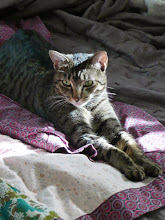Here's another version of how the Peke became part of European pet life...as fluffy war spoils. Bonus mention of Queen Victoria's dog Lootie.
* * *
It is conceivable that until the year 1860 no European had ever looked upon a Palace dog. . . .In the year just mentioned the allied French and British forces entered Peking and sacked the Summer Palace. The Court had already fled to the interior, and in their flight they left behind five of their little dogs. Lord John Hay, who was present on active service as captain in H.M.S. Odin, gives a graphic account of the discovery of these uniquely attractive dogs in a part of the gardens frequented by an aunt of the Emperor, who had committed suicide on the approach of the enemy. Lord John himself, and another naval officer, a cousin of the Duchess of Richmond's, each secured two specimens, and the fifth was taken by Lieutenant (afterwards General) Dunne, of the 99th Regiment. These five dogs were brought home to England. None had found their way into the French camp, and it was ascertained that the others had all been carefully removed to Jehal with the Court. It is, therefore, presumed that these five were the only Palace dogs, or Sacred Temple dogs, which reached this country at that time.
These five little orphans, probably sisters and brothers, were all diminutive sleeve dogs. The one secured by Lieutenant Dunne, appropriately named Lootie, was presented to Queen Victoria, who kept it at Windsor until its death some ten years later. Lootie was so tiny that she could lie at length in Lieutenant Dunne's forage cap, and it is not necessary to cast doubt upon her littleness by arguing that the future General must have had a very large head.
The two appropriated by Lord John Hay were Schlorff and Hytien. . . . Hytien was a bitch, not red, but black and white, with markings like those of a Japanese, and she was given to Lord John's sister, the Duchess of Wellington, who kept up the breed at Strathfieldsaye, presumably by the means of Schlorff, who lived for eighteen years. The other brace were given to the Duchess of Richmond, and it was from this pair, which lived to a respectable old age at Goodwood, that so many of the breed now in England trace their descent.
- Robert Leighton, The Complete Book of the Dog (Cassell, Limited, 1922) pp 280-81, from a section titled "The Little Dogs of Luxury."


No comments:
Post a Comment